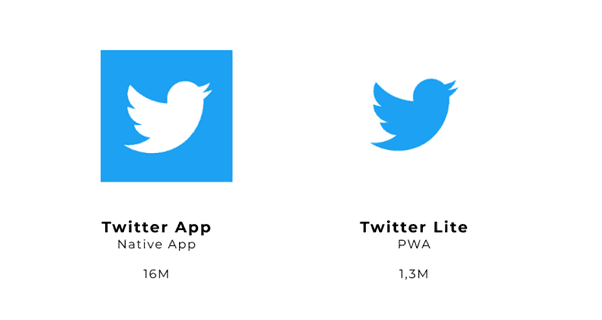What do you get when you take the best elements of the web and combine them with the best elements of mobile apps? A Progressive Web App.
Progressive Web Apps are easier to develop, more interactive, and a fraction of the price to produce.
If you’re looking to increase your engagement with your customers, then you’ve found the golden ticket.
What is a progressive web app?
As mentioned, progressive web apps are a fusion of web and mobile apps. Think of it as a platform that is built using web tech but has the functionality and feel of an app.
Progressive Web Apps can be installed on the home screen, they can receive push notifications and they can also work offline!
Think of all the steps involved in downloading an app…
Discovery on App Store
Download
Install
Open
There’s a lot of admin involved. When it comes to progressive web apps, your users will be able to start using them immediately and cut out all the extra steps involved!
Using these progressive web apps, you will dramatically increase your performance and retention rate.
Over 3 months, Pinterest rebuilt its platform as a Progressive Web App and it leads to a massive increase in numbers! See for yourself.
Twitter also rebuilt their platform, seeing:
A 65% increase in pages per session
75% more tweets
A 20% decrease in bounce rate
All while reducing the size of their app by over 97%.

Let’s break down how a PWA should behave.
These are some of the key characteristics that make up a PWA, and what you could consider when developing your own.
Progressive. A progressive web app must work on any device and take advantage of any features available on the user’s device and browser.
Discoverable. Because a progressive web app is a website, it should be discoverable in search engines. This is a major advantage of apps on the Play Store or App Store.
Linkable. As another characteristic inherited from websites, a well-designed website should use the Uniform Resource Identifier (URI) to indicate the current state of the application. An example of this is: ‘HTTP:’ or ‘mailto:’
Responsive. A progressive web app’s UI must fit the device’s form factor and screen size.
App-like. A progressive web app should look and act like a native app. This includes minimising page refreshes.
Connectivity-independent. It should work even when there is low connectivity to your Wi-Fi or data usage.
Re-engageable. Progressive web apps are intended to achieve the same goals as apps through features such as push notifications.
Installable. A progressive web app can be installed on the device’s home screen, making it easily available to users.
Fresh. When new content is published and the user is connected to the Internet, that content should be immediately available to users.
Safe. Because a progressive web app has a more intimate user experience and because all network requests can be intercepted through service workers, the app must have a high level of security!
Read more with the Beginners guide to coding a PWA
Will progressive web apps replace native apps?
Well, no. They go together like wine and cheese. Let’s compare the benefits of each:
Progressive Web Apps
More reach and discoverability through the web.
Organic traffic can be easily impressed due to the fast and sleek experience.
Easy installation and minimises the barriers involved with adding to your device.
PWA’s are an excellent way to push customers through the conversion funnel.
Native Apps
A higher level of commitment to download – however, is a good indicator of customers willing to convert to your business.
They are better suited to existing user habits.
Can send push notifications to iOS users.
Native apps are a great “home” for your biggest fans.
Google puts it this way:
“PWAs don’t have to replace native apps; they can work in tandem with them. Retailers, for instance, can use a native app to engage loyal users who are more likely to install an app but use a PWA to easily reach new users. Users who interact with the PWA can then be prompted to download the mobile app in the future”.
However, one of the biggest factors in developing an app comes down to the price, developing a native app easily can cost 5x more than your website!
So, if you’re on a limited budget, then a PWA is a great alternative!
The below chart gives a brief overview of the pros and cons of the platforms.
Differences in pricing
You might be wondering how big of an investment a progressive web app is?
Well like any good marketing mentor will tell you, “It depends”. A progressive web app can cost between $3,000 and $20,000. Depending on a variety of variables, such as:
Design Complexity
Functionality
Features Integrated
Like with any web or app development the more bells and whistles it has, the pricier it will be.
If you’ve been thinking about upscaling your business and wanted to have a chat about some of your options click here to book a call with one of our staff. We’re happy to listen and work out the best path for you and your company.
Thanks for reading 😊







